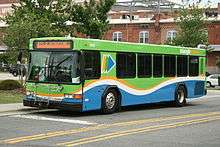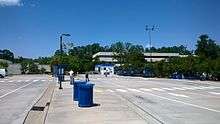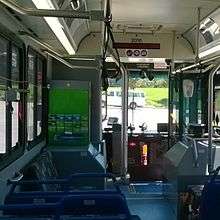GoTriangle
 | |
| Founded | 1989 |
|---|---|
| Headquarters | 4600 Emperor Blvd. Durham |
| Service area | The Research Triangle |
| Service type | bus service, express bus service, park and ride, paratransit |
| Stations |
Regional Transit Center, 901 Slater Rd. Durham |
| Website | http://www.gotriangle.org/ |
The Research Triangle Regional Public Transportation Authority, known as GoTriangle, previously Triangle Transit, and originally Triangle Transit Authority or TTA, provides regional bus service to The Triangle region of North Carolina in the counties of Wake, Durham and Orange. The GoTriangle name was adopted in 2015 as part of the consolidated GoTransit branding scheme for the Triangle.
History
The 1989 session of the North Carolina General Assembly enabled the creation of the Triangle Transit Authority as a regional public transportation authority serving Durham, Orange and Wake counties. The new unit of local government was chartered by the NC Secretary of State on December 1, 1989.
In 1991, the NC General Assembly, subject to County approvals, authorized Triangle Transit to levy a vehicle registration tax of up to $5 per registration. This tag tax finances the regional bus operations, vanpooling program and planning program.
In 1997, the NC General Assembly, subject to County approvals, authorized Triangle Transit to levy a rental vehicle tax of up to 5% of gross receipts. This tax, effective January 1, 1998, will finance future capital projects.
Triangle Transit was created to plan, finance, organize and operate a public transportation system for the Research Triangle area. It has three main program areas:
- Regional bus service
- Vanpool service
- Regional transit planning
From 1995, the cornerstone of Triangle Transit's long-term plan was a 28-mile rail corridor from northeast Raleigh, through downtown Raleigh, Cary, and Research Triangle Park, to Durham using DMU technology. There were proposals to extend this corridor 7 miles to Chapel Hill with light rail technology. However, in 2006 Triangle Transit deferred implementation indefinitely when the Federal Transit Administration declined to fund the program.[1] Planning began on a new light rail project between Durham and Chapel Hill in 2013.[2]

On March 17, 2008, after 15 years as Triangle Transit Authority, the Board of Trustees changed the agency's name and logo to Triangle Transit. Triangle Transit Board Chair Sig Hutchinson announced its new promise to the Triangle:
Triangle Transit improves our region’s quality of life by connecting people and places with reliable, safe, and easy-to-use travel choices that reduce congestion and energy use, save money, and promote sustainability, healthier lifestyles, and a more environmentally responsible community.
GoTriangle is governed by a thirteen-member Board of Trustees. Ten members are appointed by the region's principal municipalities and counties and three members are appointed by the North Carolina Secretary of Transportation.
Routes and services




Go Triangle is a regional public transportation provider, offering a wide variety of transit and vanpool services to North Carolina’s Triangle Region and outlying counties. Regional bus and shuttle service is available to Apex, Cary, Chapel Hill, Durham, Garner, Hillsborough, Knightdale, RDU International Airport, Research Triangle Park, Raleigh, Wake Forest, Wendell, and Zebulon.
Go Triangle is a supporting agency of the Special Transit Advisory Commission's work to plan for the region's transit future. The STAC completed its work in May 2008 and has provided its recommendations to the area's two planning organizations: Capital Area Metropolitan Planning Organization (CAMPO) and Durham-Chapel Hill-Carrboro Metropolitan Planning Organization (DCHC MPO).[3]
Route list
| No. | Route |
|---|---|
| 100 | Regional Transit Center to RDU Airport to Raleigh |
| 102 | Raleigh to Garner |
| 105 | Regional Transit Center to Raleigh |
| 201 | North Raleigh to Regional Transit Center |
| 300 | Cary to Raleigh |
| 301 | Regional Transit Center to Cary to Raleigh |
| 305 | Lake Pine to Cary to Raleigh |
| 311 | Regional Transit Center to Apex |
| 400 | Durham to Chapel Hill |
| 405 | Durham to Chapel Hill |
| 420 | Hillsborough to Chapel Hill |
| 700 | Regional Transit Center to Durham Tech to Downtown Durham |
| 800 | Regional Transit Center to Southpoint Mall to Chapel Hill |
| 805 | Regional Transit Center to Woodcroft to Chapel Hill |
| CRX | Chapel Hill to Raleigh Express |
| DRX | Durham to Raleigh Express |
| JCX | Johnston County Express |
| KRX | Knightdale-Raleigh Express |
| ODX | Hillsborough to Durham Express |
| RSX | Duke University to UNC-Chapel Hill - Robertson Express |
| WRX | Wake Forest-Raleigh Express |
| ZWX | Zebulon/Wendell-Raleigh Express |
Connecting local municipal transit systems
GoRaleigh
GoRaleigh serves Raleigh from 4:30am–12:00am Monday-Saturday, and 8:00am–8:00pm Sunday with 41 public transit routes (CAT also operates the Historic Raleigh Trolley Tour), and operates GoTriangle's Wake Forest-Raleigh Express, Zebulon/Wendell-Raleigh Express and Knightdale-Raleigh Express routes. During regular service hours (5:30am–7:00pm Monday-Saturday) there are 18 radial routes that serve Moore Square Transit Station in downtown Raleigh, 7 connector routes, which do not serve Moore Square Transit Station, 2 express routes, one of which serves Moore Square Transit Station, and the R-Line, a downtown circulator.
Chapel Hill Transit
Chapel Hill Transit operates public transportation services within the contiguous cities of Chapel Hill and Carrboro, and on the campus of the University of North Carolina at Chapel Hill, in the southeast corner of Orange County, North Carolina.
C-Tran (Cary)
Public transit in Cary is provided by C-TRAN. There are six fixed-routes. There is also a door-to-door service for the elderly (55+) and riders with disabilities.
Orange Public Transportation
The Orange Public Transportation program, a division of the Orange County Department on Aging, offers van and bus service outside the Chapel Hill-Carrboro city limits including planning and coordinating for county residents with transportation needs. It serves the general public and the clients of community service agencies, primarily in rural areas of the County.
GoDurham
GoDurham, the transit system for the city of Durham, operates 19 fixed bus routes as well as paratransit services.
Durham–Orange light rail
GoTriangle is planning a 17.1-mile (27.5 km) light rail line between the University of North Carolina at Chapel Hill and East Durham, traveling through Duke University and paralleling the North Carolina Railroad alignment through Durham.[4] Estimated to cost $1.85 billion.
The line is projected to begin construction in 2020 and be complete by 2026.[5] End-to-end travel time will be 42–44 minutes.[6]
A final environmental impact statement was released by GoTriangle in February 2016, projecting 23,020 daily riders for the line in 2040.[6] This will comprise 17 stations (4 in Orange County, 13 in Durham County).[7]
References
- ↑ "TTA gives up on federal funding for rail project". Triangle Business Journal. Retrieved 30 November 2012.
- ↑ Djinis, Elizabeth (May 20, 2013). "Light rail may improve Duke-Durham connections". The Chronicle. Retrieved 30 May 2015.
- ↑ "Welcome to the Regional Transit BluePrint website!". Archived from the original on May 17, 2008. Retrieved May 27, 2008.
- ↑ Sorg, Lisa (January 14, 2015). "Triangle Transit proposes major changes to light rail in Durham". Indy Week. Retrieved 30 May 2015.
- ↑ "Durham-Orange Light Rail Transit Project: Newsletter 2014" (PDF). OurTransit Future. Triangle Transit. Retrieved 30 May 2015.
- 1 2 "Durham-Orange Light Rail Transit Project Durham and Orange Counties, North Carolina Combined Final Environmental Impact Statement and Record of Decision" (PDF).
- ↑ "SmartTransitFuture.org - DOLRT at a glance".
External links
| Wikimedia Commons has media related to Triangle Transit Authority. |
